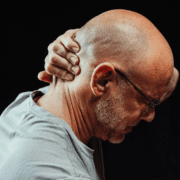Frozen Shoulder: Why the “Quick Fix” May Set You Back
If you’ve ever suffered from a “frozen shoulder,” you know firsthand how debilitating it can be.
The shoulder pain and stiffness make it hard to reach into cabinets, fasten a seatbelt, or even sleep comfortably – and this condition can hijack your life for months, sometimes even years. The bigger problem is that the usual advice – to just “wait it out,” get a cortisone shot, or let a surgeon force the shoulder to move under anesthesia – can often do more harm than good. But there is a better way forward, and it involves working with your body instead of against it.
What exactly is frozen shoulder?
Frozen shoulder, also known as adhesive capsulitis, occurs when the capsule around your shoulder joint becomes inflamed and tightens. It affects more women than men, most often between the ages of 40 and 60. Metabolic health plays a major role as well. Conditions like diabetes, obesity, high blood sugar, and elevated lipids significantly increase the risk, likely because they contribute to inflammation and tissue changes in the shoulder capsule. As the capsule thickens and stiffens, motion becomes restricted and pain increases. Frozen shoulder usually progresses through three stages: the painful phase, the frozen (or stiff) phase, and finally, the thawing phase. The good news is that most cases resolve on their own. The bad news is that “on their own” can mean two to three years without the right care – and that’s a long time to put your life on hold.
Why “quick fixes” don’t work
One of the most common interventions people get pushed toward is manipulation under anesthesia. On paper, it sounds appealing: you go under anesthesia with a stiff shoulder and wake up with more motion. But the reality is more complicated. A large review reported that about 14 percent of people needed a second procedure, and the overall evidence base was weak, with most studies lacking proper control groups.
Complications, though not frequent, can be serious. Tears of the capsule, labrum injuries, rotator cuff damage, bone bruising, fractures, and even nerve injury have all been reported. For a problem that often improves with proper conservative management, exposing yourself to those risks doesn’t make sense. Manipulation might have a place for rare cases that fail everything else, but it should never be your first option.
Cortisone injections are another common recommendation. While these can provide short-term pain relief, they come with a big catch. Cortisone is not a healing agent – it simply suppresses inflammation. Multiple studies have shown that repeated cortisone injections can weaken tendons and joint tissue, which may actually slow long-term healing and set you back. Frozen shoulder already has a natural life cycle, and while cortisone can blunt pain temporarily, it does not change the overall course of the disease. Worse, relying on injections can delay the real solution: restoring mobility through movement and proper rehab.
Do you have the correct diagnosis?
Another important point often overlooked is that a doctor’s diagnosis of “frozen shoulder” may not always tell the whole story. Adhesive capsulitis is commonly misdiagnosed, because many shoulder problems can look and feel like frozen shoulder in the early stages. Stiffness and pain are not unique to adhesive capsulitis – rotator cuff injuries, labral issues, arthritis, and even postural or mechanical problems can mimic it.
A 2016 case study published in the International Journal of Sports Physical Therapy highlights this problem. A patient was referred with a diagnosis of adhesive capsulitis. But when evaluated using Mechanical Diagnosis and Therapy (a form of specialized mechanical therapy), the presentation was actually consistent with what’s known as a “shoulder derangement.” Instead of requiring the long and difficult course typically associated with frozen shoulder, the patient responded quickly to specific corrective movements – achieving full pain relief and restoration of motion within just a few visits. This underscores why it’s so important not to take a frozen shoulder diagnosis at face value. The right examination makes all the difference, and sometimes what looks like frozen shoulder is actually a mechanical problem that can be resolved much faster.
What should you do?
But let’s say you do, indeed, have frozen shoulder. While it’s true that in most cases you have to let it “thaw out” and get through the freezing stage, there are natural treatments that can speed this up. Non-invasive technologies like Extracorporeal Shock Wave Therapy (ESWT) and Extracorporeal Magnetotransduction Therapy (EMTT) give your body’s natural healing mechanisms a boost to aid in both pain relief and mobility.
Shockwave therapy uses acoustic waves to stimulate healing, increase blood flow, and help tissues remodel, while EMTT uses high-energy pulsed electromagnetic fields to influence cells at the microscopic level and calm inflammation. On their own, each has been shown in recent studies to reduce pain, restore motion, and improve function. But when used together, the results are even more powerful. Shockwave helps loosen the capsule and ease pain so movement becomes possible, while EMTT supports the healing process at the cellular level. This combination accelerates recovery, making it easier to progress with the stretching and strengthening that ultimately restore long-term shoulder health.
The real power of these therapies is how they fit into a bigger plan. Specific stretching techniques, corrective mobility drills, and later, strengthening exercises are still the foundation of recovery. But when you can reduce pain and inflammation more quickly with shockwave and EMTT, you unlock the ability to move sooner and with less fear. That means you don’t just get better – you get better faster.
Final thoughts
Frozen shoulder does not require surgery, force, or repeated cortisone injections. In fact, those approaches can cause setbacks or complications that make recovery even harder. A smarter path is to combine natural, non-invasive therapies like shockwave and EMTT with guided, progressive movement from a specialist. Research is showing us that these tools can help people reduce pain, improve range of motion, and shorten recovery time – all without exposing you to unnecessary risk.
If you’ve been told to “wait it out” or to sign up for an aggressive procedure, it may be time to get a second opinion. Frozen shoulder is tough, but it is not unbeatable. With the right plan, the right tools, and the right guidance, you can move past the pain and stiffness – and get your life back.
Sound like you?
Consider speaking to one of our specialists in Downtown Portsmouth, NH. Click here to request a free discovery visit.











